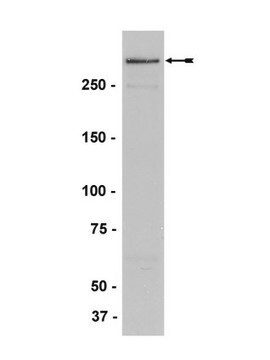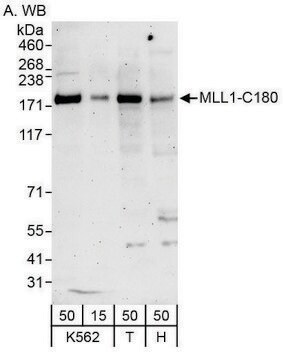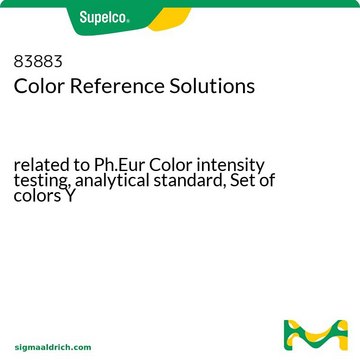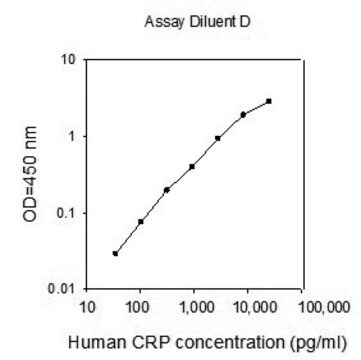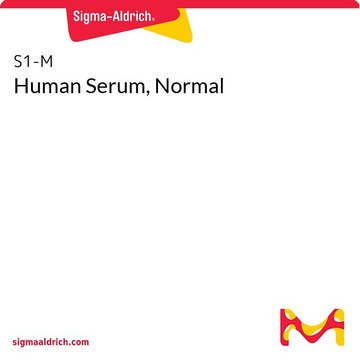05-765
Anti-MLL/HRX Antibody, CT., clone 9-12
clone 9-12, Upstate®, from mouse
Synonyme(s) :
Histone-lysine N-methyltransferase 2A, Lysine N-methyltransferase 2A, ALL-1, CXXC-type zinc finger protein 7, Myeloid/lymphoid or mixed-lineage leukemia, Myeloid/lymphoid or mixed-lineage leukemia protein 1, Trithorax-like protein, Zinc finger protein HR
About This Item
Produits recommandés
Source biologique
mouse
Niveau de qualité
Forme d'anticorps
purified immunoglobulin
Type de produit anticorps
primary antibodies
Clone
9-12, monoclonal
Espèces réactives
mouse, human
Fabricant/nom de marque
Upstate®
Technique(s)
ChIP: suitable
immunofluorescence: suitable
immunoprecipitation (IP): suitable
western blot: suitable
Isotype
IgG1
Numéro d'accès NCBI
Numéro d'accès UniProt
Conditions d'expédition
wet ice
Modification post-traductionnelle de la cible
unmodified
Informations sur le gène
human ... KMT2A(4297)
Description générale
Spécificité
Immunogène
Application
Chromatin Immnuoprecipitation (ChIP) Analysis: A representative lot detected MLL occupancy at the Hoxa10 and Meis promoters in mouse MLL-AF10 leukemia cells (Gallo, M., et al. (2013). Cancer Res. 73(1):417-427).
Chromatin Immnuoprecipitation (ChIP) Analysis: A representative lot detected an enhanced MLL occupancy at the Ink4a locus of 8-month-old than 2-month-old bEzTG mouse islets. The same age-dependent Ink4a locus enrichment was observed with H3K4me3, while the opposite trend was seen with Ezh and H3K27me3 enrichment at the same locus (Zhou, J.X., et al. (2013). J. Clin. Invest. 123(11):4849-4858).
Chromatin Immnuoprecipitation (ChIP) Analysis: A representative lot detected MLL occupancy at the HOXA10 promoter region in G179NS and G411NS human glioblastoma neural stem cells (Gallo, M., et al. (2013). Cancer Res. 73(1):417-427).
Chromatin Immnuoprecipitation (ChIP) Analysis: A representative lot detected MLL occupancy at the DNA replication origin (RD) as well as at both exon 1b and p16INK4a/p19ARF shared exon 2 in mouse embryonic fibroblast (MEF). An increased MLL enrichment at these sites was observed in senescent and Polycomb mutant MEFs (Agherbi, H., et al. (2009). PLoS One. 4(5):e5622).
Chromatin Immnuoprecipitation (ChIP) Analysis: A representative lot detected MLL occupancy at the Hoxa9 AB region using mouse embryonic fibroblast (MEF) chromatin preparation (Erfurth, F.E., et al. (2008). Proc. Natl. Acad. Sci. U.S.A. 105(21):7517-7522).
Immnuoprecipitation Analysis: A representative lot co-immunoprecipitated JmjD3 and RbBP5, but not Dnmt3a, with MLL from Min6 mouse insulinoma cell extract (Zhou, J.X., et al. (2013). J. Clin. Invest. 123(11):4849-4858).
Western Blotting Analysis: A representative lot detected higher MLL level in cultured glioblastoma neural stem (GNS) cells than neural stem (NS) cells, as well as MLL enrichment in the CD15+ fraction of freshly resected Glioblastoma (GBM) cells (Gallo, M., et al. (2013). Cancer Res. 73(1):417-427).
Western Blotting Analysis: A representative lot detected SET domain-containing C-terminal fragment of the MLL complex enzymatic subunit MLL (C180; MLLC) in anti-FLAG immunoprecipitate from HeLaS cells stably expressing FLAG-tagged hDPY-30 (Cho, Y.W., et al. (2007). J. Biol. Chem. 282(28):20395-20406).
Epigenetics & Nuclear Function
Histones
Qualité
Western Blotting Analysis: 0.1-1 µg/mL of this antibody detected MLL C-terminal fragment (C180; MLLC) in K562 nuclear extract.
Description de la cible
Forme physique
Stockage et stabilité
Remarque sur l'analyse
K562 nuclear extract
Autres remarques
Informations légales
Clause de non-responsabilité
Vous ne trouvez pas le bon produit ?
Essayez notre Outil de sélection de produits.
Code de la classe de stockage
10 - Combustible liquids
Classe de danger pour l'eau (WGK)
WGK 1
Certificats d'analyse (COA)
Recherchez un Certificats d'analyse (COA) en saisissant le numéro de lot du produit. Les numéros de lot figurent sur l'étiquette du produit après les mots "Lot" ou "Batch".
Déjà en possession de ce produit ?
Retrouvez la documentation relative aux produits que vous avez récemment achetés dans la Bibliothèque de documents.
Notre équipe de scientifiques dispose d'une expérience dans tous les secteurs de la recherche, notamment en sciences de la vie, science des matériaux, synthèse chimique, chromatographie, analyse et dans de nombreux autres domaines..
Contacter notre Service technique